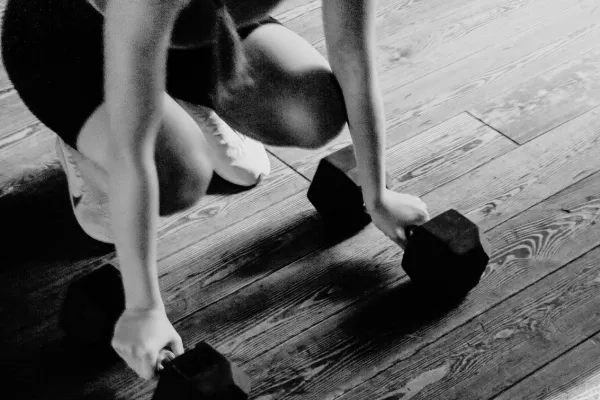
The Six Primal Movement Patterns and Why They Are Important for Functional Fitness
When you’re young, it’s easy to move freely without thinking twice about injury or the effort required to recruit muscles into performing basic activities. However, as we age, it becomes increasingly clear that moving through the world requires energy, effort and conditioning. If you’ve ever thrown your back out by picking up a sock from the floor, or if you’ve had difficulty lifting your carry-on luggage into the overhead compartment on a plane, you probably are familiar with this fact.
However, aging doesn’t have to mean throwing up your hands and yelling “Bring on the stasis!” into the void. There are exercises that you can start practicing today to help keep you vital and strong for many years to come. In fact, the earlier you start conditioning your body by doing basic strength and mobility exercises, the better chance you’ll have to stay healthy, energetic and independent as you age.
At Studio in the Heights, we talk a lot about functional fitness training—exercises that translate into real-life movements. For example, that overhead press with dumbbells that you might have encountered recently in an SPT class will help strengthen muscles like your delts, triceps and upper back. This exercise isn’t designed just to make you struggle and swear. The next time you lift a stack of dishes to place on the upper shelf of a cabinet or when you pick up your children (or grandchildren) during a very public meltdown and carry them all the way home—you can give a little nod to that overhead press for helping you participate in life’s basic activities.
When we talk about functional fitness and exercises we can do to stay vital, we can’t help but to think about the six primal movement patterns. These six patterns describe foundational human movements that form the basis of most physical activities. Understanding and training these patterns is important for building strength and preventing injury. Our Shared Personal Training sessions are built on exercises that work these fundamental patterns. The six primal movement patterns are: squat, lunge, push, pull, bend and twist. We include these exercises in our sessions not to make you suffer, but to help condition your body to become more efficient and capable in everyday tasks and to help reduce the risk of injury.
The Six Primal Movement Patterns
Squat
Bending at the hips, knees and ankles to lower the body, then straightening to return to standing.
Exercises: Sumo squat, back squat, bodyweight squat
Importance: Builds lower body strength, enhances mobility and supports everyday activities like standing up or lifting from the ground.
Real world applications: standing up from a seated position, climbing stairs, lifting and carrying heavy objects, sprinting, jumping.
Lunge
A split-leg movement involving one leg stepping forward/backward while lowering the body.
Exercises: Walking lunges, curtsy lunges, step-ups
Importance: Builds unilateral strength, improves balance and coordination, and mimics many real-life and sport-specific movements.
Real world applications: Climbing stairs, stepping over obstacles, getting out of a car, changing directions
Push
Moving an object (or your body) away from your body.
Exercises: Push-up, bench press, overhead press
Importance: Strengthens the chest, shoulders and triceps; essential for tasks like pushing a door open or lifting objects overhead.
Real world applications: Putting something heavy in an overhead space (on a plane, on the top shelf of a closet), pushing a stroller, pushing open a heavy door
Pull
Drawing an object (or your body) toward your body.
Exercises: Pull-up, row, bicep curl
Importance: Develops the upper back and biceps, supports posture and balances push movements
Real world applications: Climbing a ladder, pulling a heavy door open, pulling a heavy suitcase, carrying bags, pulling a suitcase out of a trunk
Bend
Bending primarily at the hips while keeping a neutral spine (this movement pattern is sometimes called a hinge)
Examples: Deadlift, kettlebell swing, floor touches
Importance: Strengthens the posterior chain (glutes, hamstrings, lower back) for any activity involving the lower body and helps prevent back injuries and alleviate joint pain in the hips
Real world applications: picking something up safely
Twist
Examples: oblique twists, wood chops
Importance: Helps to stabilize the spine, improve posture, help builds core strength and improves overall stability
Real world applications: vacuuming, taking clothes out of the dryer, getting out of the car
Why These Movement Patterns Matter for Functional Fitness
Exercises based on the six primal movement patterns can help improve efficiency of movement and increase power at any level: whether you’re training for a college sport or working to maintain balance as you move through the world. Training these movements can also help prevent injury, which can result from imbalances or weakness in the muscles surrounding the joints.
The glorious thing about these exercises is that they are truly for everyone and can be adapted to accommodate various proficiencies—if you’re dipping a toe into the world of functional fitness for the first time, you can start by squatting your own body weight; if you’re a linebacker for the Philadelphia Eagles, you can gear up for the season by squatting heavy weight to build strength and power to make tackles and cover receivers.
If you’re interested in exercising for functional fitness, but you’re new to the fitness world; or if you’re an athlete looking to achieve specific goals, you can sign up for a Fitness Assessment. One of our Certified Coaches will welcome you to the Studio and get you started by assessing and evaluating your movement, strength and flexibility and determining which individual or group sessions are best suited to your goals. Functional fitness is for everyone, and it’s never too late to start.
